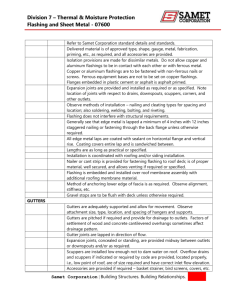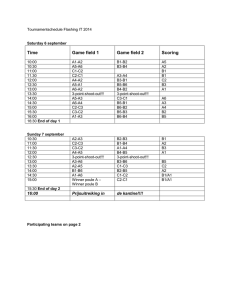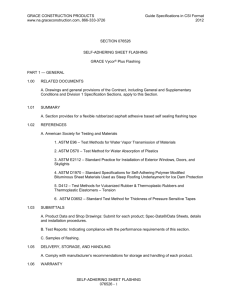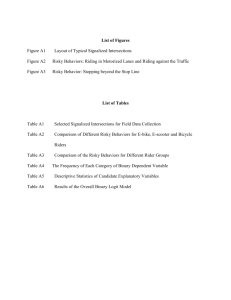section 07 62 00 - sheet metal flashing and trim
advertisement
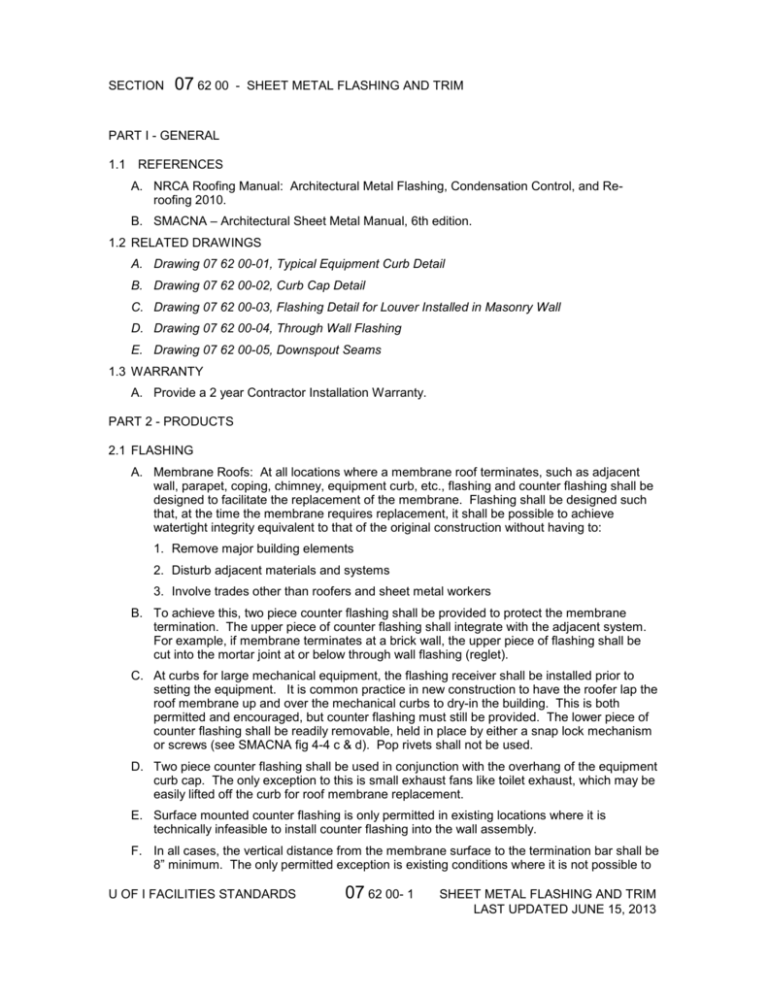
SECTION 07 62 00 - SHEET METAL FLASHING AND TRIM PART I - GENERAL 1.1 REFERENCES A. NRCA Roofing Manual: Architectural Metal Flashing, Condensation Control, and Reroofing 2010. B. SMACNA – Architectural Sheet Metal Manual, 6th edition. 1.2 RELATED DRAWINGS A. Drawing 07 62 00-01, Typical Equipment Curb Detail B. Drawing 07 62 00-02, Curb Cap Detail C. Drawing 07 62 00-03, Flashing Detail for Louver Installed in Masonry Wall D. Drawing 07 62 00-04, Through Wall Flashing E. Drawing 07 62 00-05, Downspout Seams 1.3 WARRANTY A. Provide a 2 year Contractor Installation Warranty. PART 2 - PRODUCTS 2.1 FLASHING A. Membrane Roofs: At all locations where a membrane roof terminates, such as adjacent wall, parapet, coping, chimney, equipment curb, etc., flashing and counter flashing shall be designed to facilitate the replacement of the membrane. Flashing shall be designed such that, at the time the membrane requires replacement, it shall be possible to achieve watertight integrity equivalent to that of the original construction without having to: 1. Remove major building elements 2. Disturb adjacent materials and systems 3. Involve trades other than roofers and sheet metal workers B. To achieve this, two piece counter flashing shall be provided to protect the membrane termination. The upper piece of counter flashing shall integrate with the adjacent system. For example, if membrane terminates at a brick wall, the upper piece of flashing shall be cut into the mortar joint at or below through wall flashing (reglet). C. At curbs for large mechanical equipment, the flashing receiver shall be installed prior to setting the equipment. It is common practice in new construction to have the roofer lap the roof membrane up and over the mechanical curbs to dry-in the building. This is both permitted and encouraged, but counter flashing must still be provided. The lower piece of counter flashing shall be readily removable, held in place by either a snap lock mechanism or screws (see SMACNA fig 4-4 c & d). Pop rivets shall not be used. D. Two piece counter flashing shall be used in conjunction with the overhang of the equipment curb cap. The only exception to this is small exhaust fans like toilet exhaust, which may be easily lifted off the curb for roof membrane replacement. E. Surface mounted counter flashing is only permitted in existing locations where it is technically infeasible to install counter flashing into the wall assembly. F. In all cases, the vertical distance from the membrane surface to the termination bar shall be 8” minimum. The only permitted exception is existing conditions where it is not possible to U OF I FACILITIES STANDARDS 07 62 00- 1 SHEET METAL FLASHING AND TRIM LAST UPDATED JUNE 15, 2013 achieve 8”. In locations where pavers are used, the 8” distance shall be provided from the termination bar to the top of the paver. G. Shingle and shake roofs: Flashing and counter flashing shall be installed following guidelines similar to those for membrane roofs. Where sloped roofs intersect chimneys and walls, step flashing shall be used. The top of the step flashing shall be protected by counter flashing. Chimneys and similar projections shall have metal crickets. See SMACNA fig 4-18. H. Roof accessories: All roof accessories, such as curbs, shall have a two piece counter flashing. I. All metal flashing and drainage for roofs shall be copper, stainless steel, or aluminum, as appropriate for use with adjacent materials. Lead coated copper is also permitted. J. Metal thickness shall be selected based on the exact size, configuration, and support conditions of the building. Consult SMACNA or NRCA for recommendations, but in all cases: 1. The minimum thickness for aluminum is .040. 2. The minimum thickness for stainless steel is 24 ga. 3. The minimum thickness for copper is 16 oz. K. Lapped seams shall not be used. Non-moving seams shall be flat lock (2), common lock (1), or drive cleat (4), and shall be soldered (except aluminum). L. Moveable seams shall be S pocket (6), Double S pocket (7) or butt seams with cover and/or backer plate (18, 20, 21). Seam types listed here refer to SMACNA figure 3-2. 2.2 GUTTERS & DOWNSPOUTS A. All gutters and downspouts shall be designed to accommodate a 100 year rain event in accordance with SMACNA Table 1-2. B. Where built-in gutters are used, SMACNA figure 1-4 shows two different methods for returning and terminating the gutter at the roof edge. The U of I requires that the back of the gutter have a flange that extends up the slope of the roof and which has an edge secured with cleats. See “Cleat Style” of this figure. C. An abundance of leaves from near by trees can create blockage problems in even generously sized downspouts. Unless there is a need to replicate the design of existing downspouts on a historic building, consider using open faced downspouts similar to NRCA figure 63. For traditional fully enclosed downspouts, provide openable section near base, just above footing tile leader. Openable section is to provide access to clean blockages out of the downspout as well as the leader. D. Gutters – Hung: Expansion joints for hung gutters shall be butt type joints with cover plate per SMACNA figure 1-7. E. Gutters – Built-in: Expansion joints for built in gutters shall be butt type joints with cover plate per SMACNA figure 1-8. F. Outlets shall be placed as near to the corner of the building as possible so that water will not be required to flow far beyond a sharp turn. G. Down spouts shall be anchored to the exterior wall of the building. These anchors shall be designed so that the downspout may be removed without damaging the downspout, and with minimal or no damage to the bracket. This facilitates tuckpointing and downspout replacement/repair. Downspout hangers similar to the kind shown in SMACNA fig 1-34B are suggested. H. Unless the project needs to replicate existing construction, downspouts shall not be tight to the wall. They shall stand-off 2-3”. U OF I FACILITIES STANDARDS 07 62 00- 2 SHEET METAL FLASHING AND TRIM LAST UPDATED JUNE 15, 2013 I. Downspout seams shall be soldered prior to installation (unless downspouts are aluminum). 2.3 COPING & GRAVEL STOPS A. Where coping or gravel stop of a lower building level abuts an adjacent wall, proper termination of the coping is important. Coping shall be flashed behind the outer wythe of brick in accordance with SMACNA figure 3-8D. Flashing piece shall be preformed, and all joints soldered or welded as appropriate. Flashing shall lap over final piece of coping a minimum of 4”, and lap shall be sealed. B. On membrane roofs with low parapets, membrane shall be wrapped up and over top of parapet, and coping installed over that. On buildings with tall parapets, membrane may be terminated at wall using two piece counter flashing described above. Coping may be separate from membrane termination. C. In existing construction, while it is desirable to perform proper masonry reconstruction, condition of the parapet may necessitate covering the entire back of the parapet with roof membrane or flashing metal. D. Gravel Stop/Fascia: Expansion joints in fascia and gravel stops shall be butt joints with a cover plate or backer plate. See SMACNA 2-5A and 2-5C. 2.4 THROUGH WALL FLASHING A. Through wall flashing shall be incorporated at the base of all walls where the masonry veneer sits on the concrete foundation. With the exception of entrances and doorways where it is understood that the sidewalk must be at the same level as the interior floor for accessibility, there must be a minimum of 8” vertical distance between the top of the foundation wall and the top of the adjacent finished grade. Through wall flashing (stainless steel or copper) must securely terminate at the cavity face of the cmu back-up, and must extend through the brick or stone, and form a drip edge on the exterior of the wall. B. Other applications of through wall flashing are discussed in Section 04 20 00. PART 3 - EXECUTION 3.1 END OF SECTION 07 62 00 This section of the U of I Facilities Standards establishes minimum requirements only. It should not be used as a complete specification. U OF I FACILITIES STANDARDS 07 62 00- 3 SHEET METAL FLASHING AND TRIM LAST UPDATED JUNE 15, 2013

